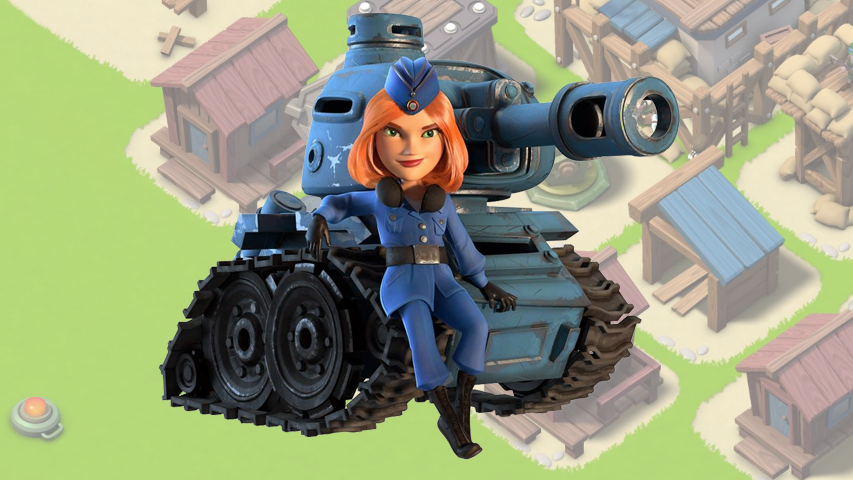
Boom Beach is the fifth worldwide release of Supercell. And the third successful one. The game is currently in the Top 10 box office apps in more than 80 countries, including the USA. A detailed analysis of the gameplay is in our material.
The reaction of many users who saw Boom Beach! for the first time is as follows: “and the Clash of Clans editors made a clone of their own game.”
The former product director at Digital Chocolate, Zynga and TinyCo, Rajeev Nagpal, completely disagrees with this.”Boom Beach is unlike Clash of Clans. Unlike, mainly due to serious differences in combat mechanics. Supercell has done an admirable job of preserving the part that basically generated money (construction and improvements) and seriously changed the battles.”
Mikhail Katkoff, who currently holds the position of executive producer at Zynga, agrees with him: “Despite several similarities, Boom Beach is essentially a new, unique game.”
Nagpal also notes that once again Supercell was inspired by the creations of the American studio Kixeye: “Boom Beach is the most simplified version of two Kixeye projects at once – War Commander and Battle Pirates. Clash of Clans was a casual version of their other title – Backyard Monsters.”
Reference: Kixeye develops and publishes hardcore browser strategies. It was established in 2007. I started with the development of Flash games. The company released the first hardcore title Backyard Monsters in May 2010. Today, the company employs more than 400 employees. Kixeye operates five free-to-play games, whose total MAU is more than 5 million.
And indeed, with a close acquaintance with War Commander and Battle Pirates, the question of where the Finns drew inspiration from is removed.
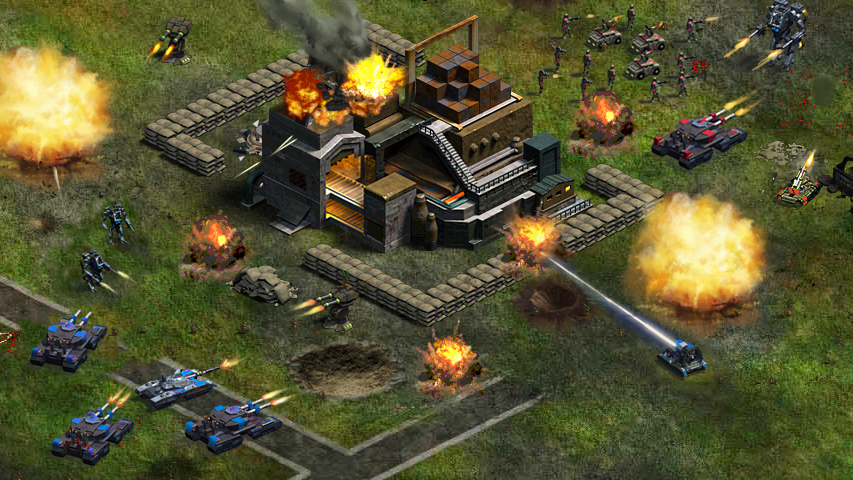
Another thing is funny: in 2011, Kixeye stated that it aims to make time managers for real gamers, games that the company itself will be interested in developing. This policy has borne fruit. The company has occupied a certain niche, regularly bringing Kixeye income. But the company that decided not to turn away from a wide audience was able to make really good money on the solutions it implemented.
Returning to Boom Beach.
Our analysis of the latest Supercell game is structured as follows: we go from a brief concept of the project to a description of its game cycle, through the prism of which we consider the main components of the game.
Content:
- Brief concept
- Game cycle
- Consumables
- Price dynamics
- Construction part of the game
- Macrochast
- Battles
1. Brief concept of the game
In Boom Beach, the player acts as the commander of a military base located on one of the many islands of the archipelago somewhere in the ocean. The player rebuilds the base (erects resource and defensive structures), forms a fleet (builds landing ships, puts mercenaries on them), attacks the bases of other players (he opens access to them by removing the “fog of war” from the map), gets experience and resources for this, which go to further improve the base. Victory points received for battles affect the position in the ranking.
2. Game cycle
According to the founder of GameAnalytics, Matthias Hansen, the game can be reduced to one game cycle, which is divided, as in Clash of Clans, into three components: resource collection, construction and improvement, and war.
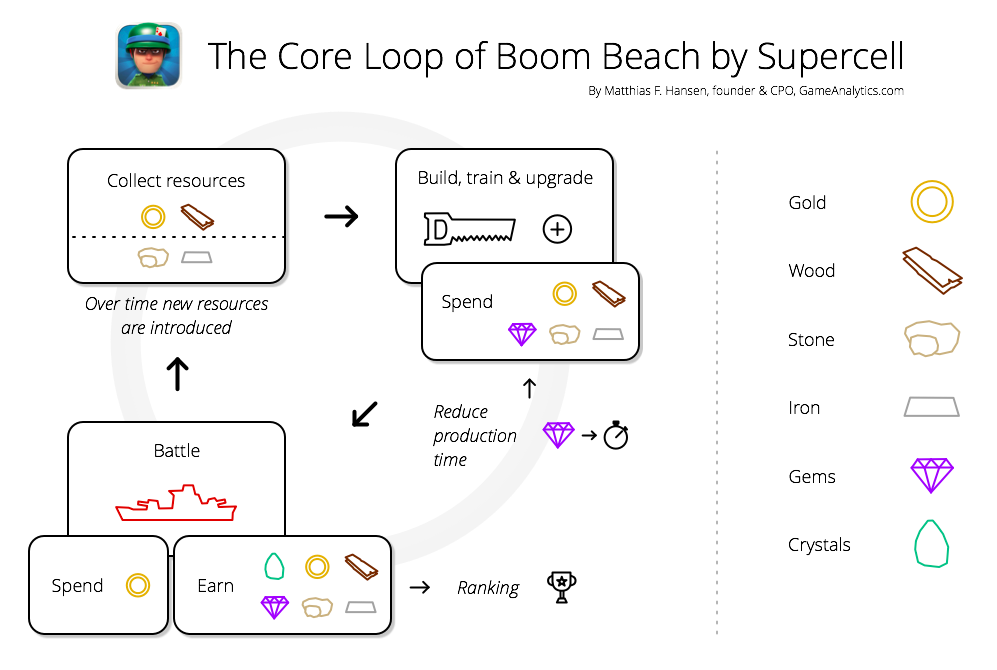
You collect resources, build buildings by spending resources, then attack, make money on it, collect resources and build something again.
The scheme is accurate and, importantly, demonstrates the variety of consumables, which we will talk about later, as well as the presence of a single game cycle.
At the same time, we can’t help but cite another gameplay scheme of the game – from ANIL DJI (ANIL DG), producer and designer of Mind Candy. It breaks the Boom Beach game cycle into two components: construction and combat.

DJI considers awards (resources) to be the central component that unites the construction and combat units.
In my opinion, it is less obvious, so we stopped at Hansen’s scheme, decided to consider each stage of the game cycle by its example.
3. Consumables
Consumables are all game variables that the user can somehow earn or spend in the game.
There are five types of consumables in the game.
Hard currency
Diamonds are a familiar free-to-play consumable. There are several sources of diamonds in the game.
- They can be bought for real money;
- they are issued for completing achievements in the game;
- every day a small number of them are generated on the world map;
- in case of an attack on your settlement, you also get diamonds.
Important: crystals are the only resource that can be purchased for real money.
Hard currency is spent on:
- Accelerating the production of anything;
- replacement of the soft currency necessary for the production of something.
Soft currency
Soft currency is also a familiar aspect of such games. It is extracted in different ways:
- Generated automatically in the corresponding buildings;
- Generated on captured islands;
- Issued as a bonus for battles;
- Wood and stone can also be obtained by cutting down trees and breaking stones, respectively, at your base.
Unlike a hard currency, it has a storage limit (depends on the storage level of the corresponding resource).

Its surpluses are lost.
Important: soft currency cannot be bought for real money at all. If you do not have enough resources to build / buy / improve anything, the game offers to add a few crystals according to the course that is set by the developers.
There are four types of soft currency in the game:
- Gold is spent on buying troops, upgrading them, upgrading the gunboat, opening new zones and attacking.
- Tree – used in the improvement and construction of all buildings in the game.
- Stone – used in the improvement and construction of all buildings in the game at a relatively high level of development.
- Iron is used in the improvement and construction of all buildings in the game at the highest level of development.
Social consumables
As a rule, they are not considered consumables, however, the fact that the actions of a player in Boom Beach can lead to both their increase and their decrease allowed us to talk about game victory points as a kind of consumables.
Victory Points are awarded for exploring territories and winning battles. Affect the position in the top. They are taken away in case of losing the battle (including in case of looting of your base and capture by another player of one of your villages).
Consumables for the “Builder” building
It is a rare case when there is another chain operating around one of the game buildings within the game ecosystem, and even operating with almost 13 types of resources.
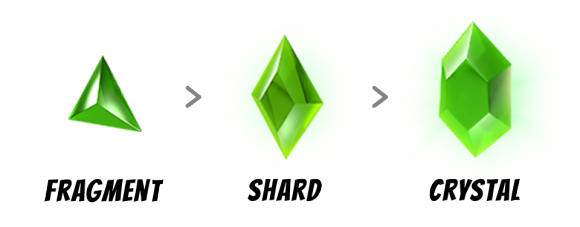
So, there is a “Builder” building in the game. With its help, statues are erected that work as permanent passive game bonuses. Statues are being erected for crystals. Crystals are issued in case of an attack on other settlements (but not always).
Crystals are divided by size into three types (a fragment of a crystal, a piece of a crystal and a whole crystal), each of which is further divided by color into four types. To build a small statue of a certain color, you need to collect several fragments of the same color to build a larger statue, several pieces of crystals, and so on.
- Green statues (life) give bonuses in construction and production;
- red statues (magma) increase the strength and health of troops;
- purple statues (darkness) increase the possible reward for battles, ship energy;
- blue statues (ice) increase the power of combat structures.
The performance of the statues is also affected by the power powder. This is a resource that the player receives for improving statues. The Power Powder temporarily doubles the bonus given by the statues.
Crystal hunting is not the main, but a pleasant component that stimulates the combat part of the game.
Military consumables
Another consumable, which is rather a property of one of the units. We put it in the consumables, because the player can increase its number during the battle.
A military resource is the charges that are spent by a gunboat during an attack on an enemy settlement. The maximum number of them at the beginning of the attack depends on the level of the gunboat. During the battle, the number of charges can be replenished in case of destruction of buildings by soldiers. Replenished instantly with every battle.
Six possible attacking bonuses are acquired for charges during the battle.
Total by resources
On paper, you can get lost in all this diversity. The huge advantage of Boom Beach is that, despite, in fact, 22 game consumables (!), even a casual player can easily figure it all out.
There are three secrets.
The first secret: at the beginning of the game, the user is presented with only three types of resources (diamonds, gold and wood), over time (after a couple of hours of play) they also have to think about two more (stone and gold).
The second secret: consumables are divided into logical groups (this one is for money, these are resources, it’s generally necessary to save for bonuses, and this is a gunboat clip, and so on).
The third secret: roughly speaking, the user needs to think only about resources. Yes, the player can draw, conditionally, schemes, which attack strategy will be most effective in the presence of three types of gunboat attack and with the number of charges equal to 22, but this is not necessary to enjoy the game.
About the reasons for the diversity of soft currency (+ about price dynamics)
As many as three construction resources (wood, stone and iron) were introduced into the game, of course, for a reason. There are a lot of moments in Boom Beach, whose task is mainly to prevent content from burning out quickly. Two additional, at first glance, unnecessary resources are just from this “opera”.
A large number of resource types forces the player to repeatedly go through cycles of accumulation and spending throughout the game (first you need a little wood, then more, then even more, and then a stone appeared, which you need a little bit first, then a little more, and so on).
The player is being twisted more and more, forced to do more and more actions in the game, as well as wait more and save more. But, it is important, this is not done immediately (they do not give a butt on the head, forcing them to accumulate all kinds of resources at once), but gradually.
What else do the main resources provide?
- New buildings (mines and storage facilities) that slow down the development of the base, because they need to be built, improved (slow burnout of content);
- Slowing down the passage of the main game cycle (slow burnout of content);
- An additional incentive to attack enemy bases (rare resources can be collected faster by attacking, rather than waiting for the “farm” on the home base to generate them);
- Increased spending of hard currency on buildings (there are always not enough additional resources, it is easier to replace a thousand stones with a dozen collected diamonds).
The problem with the diversity of resources is the same: developers need to take into account the importance of each building, each update in the price plan, parallelize this value into three streams, and also play with the diamond rate in relation to each resource.
It’s difficult, it takes months of testing.
Yes, another reason why so many construction resources could have been introduced is to solve the problem of slow progress at high levels.
If there was only one resource, developers would have to choose either to make the price curve for buildings and upgrades such that the content would not burn out (for this, each new improvement would have to cost a lot), but then the dynamics would suffer. Or, accordingly, leave the curve less steep, but stamp more content.
Resources removed this problem by laying several not very steep price curves at once, in general, repeating each other.
I have built two graphs of the price dynamics for the upgrade of two different buildings to demonstrate this.
The first chart: Price dynamics of the improvement of the “Gold Storage” (level 1 -10)
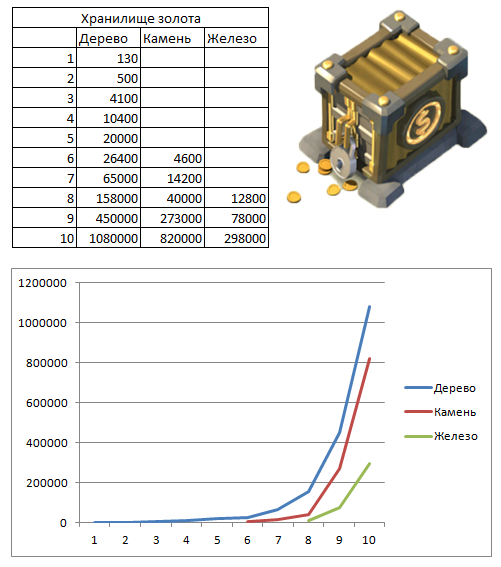
In a particular case, it is important to understand that the level 10 of the gold vault is currently the maximum, but, in general, it is clear that in Boom Beach additional resources play the role of a “sinker”, they throw up the complexity of accumulation, and their dynamics of value formation, in general, is similar between all types
Second chart: Price dynamics of the Gunboat upgrade (level 1 – 10)

It may seem that the gunboat has a completely different price dynamics, but it is important to understand that level 10 is not the maximum for it. If we take into account all 20 levels, then the dynamics will not differ much.
Price dynamics of Gunboat improvements (level 1 – 20)
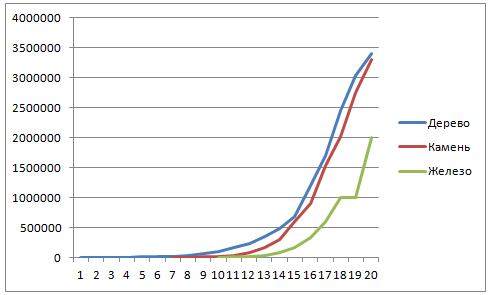
Of course, with one correction – the cost in hardware when reaching the 1 million mark with the next upgrade remains the same. But the dynamics of price growth of wood and stone are very similar.
Construction
An important difference between Boom Beach and Clash of Clans (and one more thing that makes the game akin to hardcore games, like those that Kabam does) is that at a certain point in time, only one building can be built/improved.

This decision, most likely, was also made in connection with the desire to slow down the burnout of content, since, obviously, the impossibility of building several buildings at the same time greatly slows down progress.
Plus, as you know, the main thing that time managers earn is human impatience. With the rejection of the possibility of erecting a larger number of builders’ gatehouses, Supercell has increased the efficiency of monetization points. If earlier it was possible to persuade yourself to wait, because up to five construction sites could work at the same time, now you always need to wait.
In the construction part , the player builds three types of buildings:
- Responsible for the economy (production and storage of resources);
- Responsible for protection (they are, in fact, designed to protect accumulated resources from other players);
- Responsible for support (buildings, building troops, improving them).
Every building can and should be improved. The main structure is the “Headquarters”. The higher its level, the more types of buildings and more of them can be built.
Simply put: almost every type of building has two types of binding to the headquarters level: the maximum possible number of buildings and their maximum level.
Example one
The “Residence” building, which generates gold, can be erected if there is a first-level headquarters. The second residence only after upgrading the headquarters to the second level. The fourth one will be allowed to be rebuilt only if you have built a seventh-level headquarters.
Improvements occur according to a similar scheme. You will be allowed to upgrade the residence to the second level at the headquarters of the first. For the third level of the residence, however, it will be necessary to upgrade the headquarters to the second level and so on.
It is clear that each subsequent upgrade requires an increasing number and, importantly, the number of resources.
Example two
For the production of a level 1 tank in the armory, a level 11 headquarters is needed. But for the production of a level 3 tank, a level 10 armory is required, for the construction of which a level 12 headquarters is needed, and so on.
There is no direct connection between the secondary buildings. That is, if you want a cool gun, you don’t need to build, for example, any guild of builders / architects. This is a plus, since it deprives the game of a complex hierarchy.
However, there is still a certain connection (cycle) between them. It’s simple:
New cool building
Requires
New headquarters
Requires
Higher player level
Requires
Construction and upgrade of all other buildings
So it turns out that in order to build something cool, you first need to build everything that can be built. The cycle turned out to be a bit rough, there are more specific bundles, of course, but the scheme works like this.
Macro level
In addition to the base, there is also a map of the archipelago. As already mentioned, she initially drowns in the “fog of war”. The fog of war is revealed in small pieces for money. To be able to open a couple of extra pieces for money, it is necessary to build and then constantly improve the radar on the base.

The archipelago map is something like the map from the Clash of Clans single. An important difference: it has bases and villages not of virtual opponents, but of real players. Villages with a successful attack pass to you, after which they generate gold. With the bases of real players, the following happens: for you, they turn into ordinary villages.
In other words, in Boom Beach, in fact, there is no PvC. There is an asynchronous PvP that pretends to be PvC.
There are also resource-producing bases on the map that generate not gold, but one or another type of resource and may also belong to other players. Unlike villages in them, as well as on the main base, it is possible to rearrange buildings and combat guns.
With regard to the map, it should be noted that: if in Clash of Clans there was an opportunity to scroll through dozens of bases in search of “meat”, then in Boom Beach there is no such opportunity. Instead, when the “fog of war” is dispelled, the opponents who are closest to him in medals are selected for the player, and, attention, whom he most likely will not be able to defeat the first time.
Another interesting point is the constant “tug of war”. There is a constant war going on for villages (not bases). Such villages are captured relatively easily, so this, conditionally, component is more dynamic than the one in which there is an attempt to capture enemy bases.
So that life does not seem like honey, after each “flag change” the villages increase in level (this means that the number and level of protective weapons increases in the village or resource base).
A small addition: in fact, there is still some minimal PvC, these are events, as well as rare “plot” bases, for which delicious buns are given. But PvC is kept to a minimum.
The archipelago map plays an important, but “bonus” role in the economy of the game (generates resources) and stimulates the military component (was the village taken away from the player? he went to return it).
Battles
In order to attack someone else’s village or base, it is enough to tap on the enemy’s fortification on the archipelago map. This displays a window that offers to look at the base, attack (gold is spent on the attack, the amount required for the attack depends on the player’s level).

The battles are very similar to those in Clash of Clans. That is: you land troops with a tap in the right place and wait for what it will lead to.
But there are nuances.
- The landing of troops can only take place from one side of the enemy base;
- Units now have no “preferences”, they shoot at what they see;
- The player is now more immersed in the action, as a support vessel, a gunboat, has appeared. You can decide which type of projectile to use (medpack, shock shell, smoke screen, flyer indicating to the troops what to attack). This has greatly changed the combat unit. Battles began to resemble Majesty with its indirect control;
- Any battle ends either in complete victory or defeat. There are no stars for destroying 50% of the base. The player must destroy the enemy headquarters to win. It’s pinned the warhead;
- Surviving troops are preserved, not disappear after battles. The latter also had a very serious impact on the dynamics, but at the same time, most likely, it affected spending on hard currency. The fact is that now you can carry out an unlimited number of attacks in a row, if each battle is successful. The scheme “won, ordered troops, paid for instant spawn, went on the attack” now does not always work.
Battles, like the archipelago map, bring resources to the player.
They take us back to the beginning of the cycle. And to an important component called gaming “experience”. It depends on him:
- Maximum possible staff level;
- The amount spent on the attack.
It increases only in one way – by building new buildings and upgrading them.
Because of this, experience turns out to be an extremely important component of the gaming economy. In a way, it is a replacement for the hierarchy of buildings and one of the important points that increase the consumption of gold, whose consumption in the game is the slowest.
Actually, everything.

Instead of a conclusion
The game is still at a very early stage of development. Pricing in the game is complicated and is still being corrected, as are the dynamics of battles and the visual appearance of units. The game lacks clans, the construction part, sorry, is not as pleasing as in “clashes”. But all this does not mean that acquaintance with the game should be postponed further.
Yes, if you find that we forgot something while describing the project, write.
One more conclusion
Initially, we planned to publish a translation of an article about Boom Beach, but in the end it turned out that none of them satisfied us. But when writing something, we still used:
- Boom Beach, Is Supercell Set To Eat Kixeye’s Lunch All Over Again?
- Boom Beach – Beta Deconstruction
- Can Supercell do it again? Boom Beach analyzed
- What is Supercell’s strategy with Boom Beach?
- Boom Beach – Developing the Next Big Thing
- The Unofficial Guide: Boom Beach application (in general, such things are a storehouse of knowledge, saves a lot of time on data collection and analysis).
